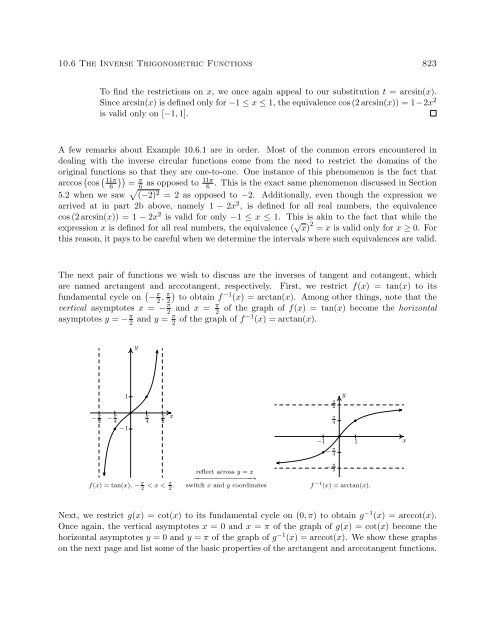Section 10.6: The Inverse Trigonometric Functions - Ostts.org
Section 10.6: The Inverse Trigonometric Functions - Ostts.org
Section 10.6: The Inverse Trigonometric Functions - Ostts.org
You also want an ePaper? Increase the reach of your titles
YUMPU automatically turns print PDFs into web optimized ePapers that Google loves.
<strong>10.6</strong> <strong>The</strong> <strong>Inverse</strong> <strong>Trigonometric</strong> <strong>Functions</strong> 823To find the restrictions on x, we once again appeal to our substitution t = arcsin(x).Since arcsin(x) is defined only for −1 ≤ x ≤ 1, the equivalence cos (2 arcsin(x)) = 1−2x 2is valid only on [−1, 1].A few remarks about Example <strong>10.6</strong>.1 are in order. Most of the common errors encountered indealing with the inverse circular functions come from the need to restrict the domains of theoriginal functions so that they are one-to-one. One instance of this phenomenon is the fact thatarccos ( cos ( ))11π6 =π11π6as opposed to6. This is the exact same phenomenon discussed in <strong>Section</strong>5.2 when we saw √ (−2) 2 = 2 as opposed to −2. Additionally, even though the expression wearrived at in part 2b above, namely 1 − 2x 2 , is defined for all real numbers, the equivalencecos (2 arcsin(x)) = 1 − 2x 2 is valid for only −1 ≤ x ≤ 1. This is akin to the fact that while theexpression x is defined for all real numbers, the equivalence ( √ x) 2 = x is valid only for x ≥ 0. Forthis reason, it pays to be careful when we determine the intervals where such equivalences are valid.<strong>The</strong> next pair of functions we wish to discuss are the inverses of tangent and cotangent, whichare named arctangent and arccotangent, respectively. First, we restrict f(x) = tan(x) to itsfundamental cycle on ( − π 2 , π )2 to obtain f −1 (x) = arctan(x). Among other things, note that thevertical asymptotes x = − π 2 and x = π 2of the graph of f(x) = tan(x) become the horizontalasymptotes y = − π 2 and y = π 2 of the graph of f −1 (x) = arctan(x).y− π 21− π 4−1π4π2xπ2π4y−1 1x− π 4f(x) = tan(x), − π 2 < x < π 2 .reflect across y = x−−−−−−−−−−−−→switch x and y coordinates− π 2f −1 (x) = arctan(x).Next, we restrict g(x) = cot(x) to its fundamental cycle on (0, π) to obtain g −1 (x) = arccot(x).Once again, the vertical asymptotes x = 0 and x = π of the graph of g(x) = cot(x) become thehorizontal asymptotes y = 0 and y = π of the graph of g −1 (x) = arccot(x). We show these graphson the next page and list some of the basic properties of the arctangent and arccotangent functions.


